
Work Time Tracking
Grownu human resource management system is designed for the management, digitization, and optimization of your company's work time tracking. With the work time tracking system, every minute of work will be planned, recorded, and accounted for.

Work Time Tracking on Mobile
Record and manage each employee's work time on their mobile phones. Plan your company's work, create employee work shifts, and track employees' work hours with Grownu.
Work Time Tracking - What is it?
Work time tracking is an activity during which working hours are monitored and recorded. It is a crucial process that allows for efficient management and planning of workdays, ensuring proper organization of work. Work time tracking helps to track how much time is spent on different tasks, projects, or meetings and ensures that work hours are utilized optimally.
Work time tracking can be performed using various methods and tools. It can be manual, where employees manually record the start and end of work time on paper. Electronic time tracking tools can also be used, automatically recording work hours through biometric time clocks or mobile devices.
Work time tracking provides numerous benefits for both employees and employers. It allows monitoring of productivity, identification of efficiency gaps, and implementation of effective work process management. Additionally, it can be useful for generating reports, calculating wages, and complying with labor laws regarding work hours and rest breaks.
Work time tracking becomes even more critical when working in shifts or following a more flexible work schedule. It helps ensure accurate calculation and management of work hours, fostering better collaboration between employees and employers and improving overall organizational efficiency.
In summary, work time tracking is a crucial activity that enables precise monitoring, recording, and management of work hours. It facilitates effective work organization, ensures accurate calculation of work hours, and enhances collaboration in the work environment.
Work Time Arrangements
Work time tracking is a crucial activity that helps efficiently manage time and increase productivity. We have taken the most popular and most used work time arrangements and described that below, but for more work time arrangements you can read in the link:
-
1. Fixed Work Time
This is a work schedule where the same days and the same number of hours are worked each week. Typically, this means 8 hours per day from Monday to Friday and it is called Full Time working mode which leads to 40 hours per week You can set the Part Time job place where employee will work 4 hours per day from Monday to Friday and it will lead to 20 hours per week.
-
2. Shift Work
A work schedule often adapted for employees working in shifts. Time tracking occurs over a specific period, and the employee must work a certain number of hours per week. Typically, the number of working hours is mutually agreed upon when the employee negotiates the terms of their work agreement. Grownu's work time tracking system is well-suited for controlling and planning shifts in this type of work time mode.
-
3. Flexible Schedule
Usually involves fixed working hours during which the employee is available to the employer. Other hours allow the employee to use at their discretion and perform assigned work when it's convenient for them. This type of work time mode is also well-suited for time tracking and work time accounting systems.
-
4. Split Work Day
This is a work schedule where employees can leave their workplace and return later, depending on the company's operational needs and, for example, uneven customer flows at certain times. This type of work activity can be effectively managed with work time tracking and shift planning systems, allowing precise scheduling and accounting of work and break hours.
-
5. Individual Work Time
The most flexible work time arrangement, often used by specialists in various fields whose work is independent of other company employees, and they don't need to communicate with clients during set working hours. A work time tracking system can facilitate the registration of working hours for such employees and help employers account for their actual work.
It is essential to choose a method that best suits the individual needs and work style of the company. The flexible and adaptable Grownu work time tracking system can be effectively utilized in various companies based on their chosen work time mode. Contact Grownu to discover the work time tracking solutions awaiting your company!
Work Time Registration and its Types
Work time tracking and registration is a crucial process for companies, helping them efficiently manage their employees' work hours and ensure productivity. It involves accurately calculating the costs of completed tasks' work time and analyzing employees' efficiency. Digitizing your company's work time tracking table and integrating it with existing accounting systems can digitize and optimize your company's operations. Today, there are numerous ways to register work time and control the resources and employees your company has.
Traditional work time registration technologies, such as time cards or clocks, allow precise recording of the time when a specific task, job, or project starts and finishes. Paper forms are filled with start and end times, handed over to responsible managers who then transfer the data to an Excel spreadsheet and submit it to the company's accounting department. These tools are simple and accessible to everyone, ensuring accurate time tracking and schedule adherence, but they leave room for speculation as control is delegated to employees.
In the era of business process digitization, one of the most popular methods is to use time registration and tracking software, both for mobile and desktop versions. These programs allow you to record and track employees' work time, set priorities, create tasks or shifts, and monitor their progress. They can also send reminders and alerts that help maintain focus, organization, and control over work time.
Additionally, tools that can be installed in web browsers are popular. These tools track how much time is spent reading emails, browsing social networks, or visiting specific websites. They can provide detailed statistics on employees' activity in the workplace, helping understand how much time is dedicated to ineffective behavior. This doesn't mean that such systems are used for internal punishment but rather the opposite—they help each employee individually understand where their effective work time is spent during the day, week, or month.
In mobile jobs, such as in construction industry, cleaning companies, pest control companies, and maintenance and repair activities, mobile devices are used to allow employees to conveniently mark where a chosen task is performed—on-site or on a project. Automatic marking of the start and end of work time when entering or leaving geo-zones set for each work location is also commonly used.
All these methods help us understand how and where we spend our time, encouraging us to manage it more effectively. Regardless of the chosen method, the most important thing is to consciously register and monitor employees' work time and use tools that best suit your company's needs, work style, and activities.
Shift and Work Time Planning
Shift and work time planning is a crucial process that allows for the effective organization of workforce distribution and ensures that necessary tasks are completed at the right time. This involves creating organized shift schedules, calculating work hours, managing break times, and overall time management.
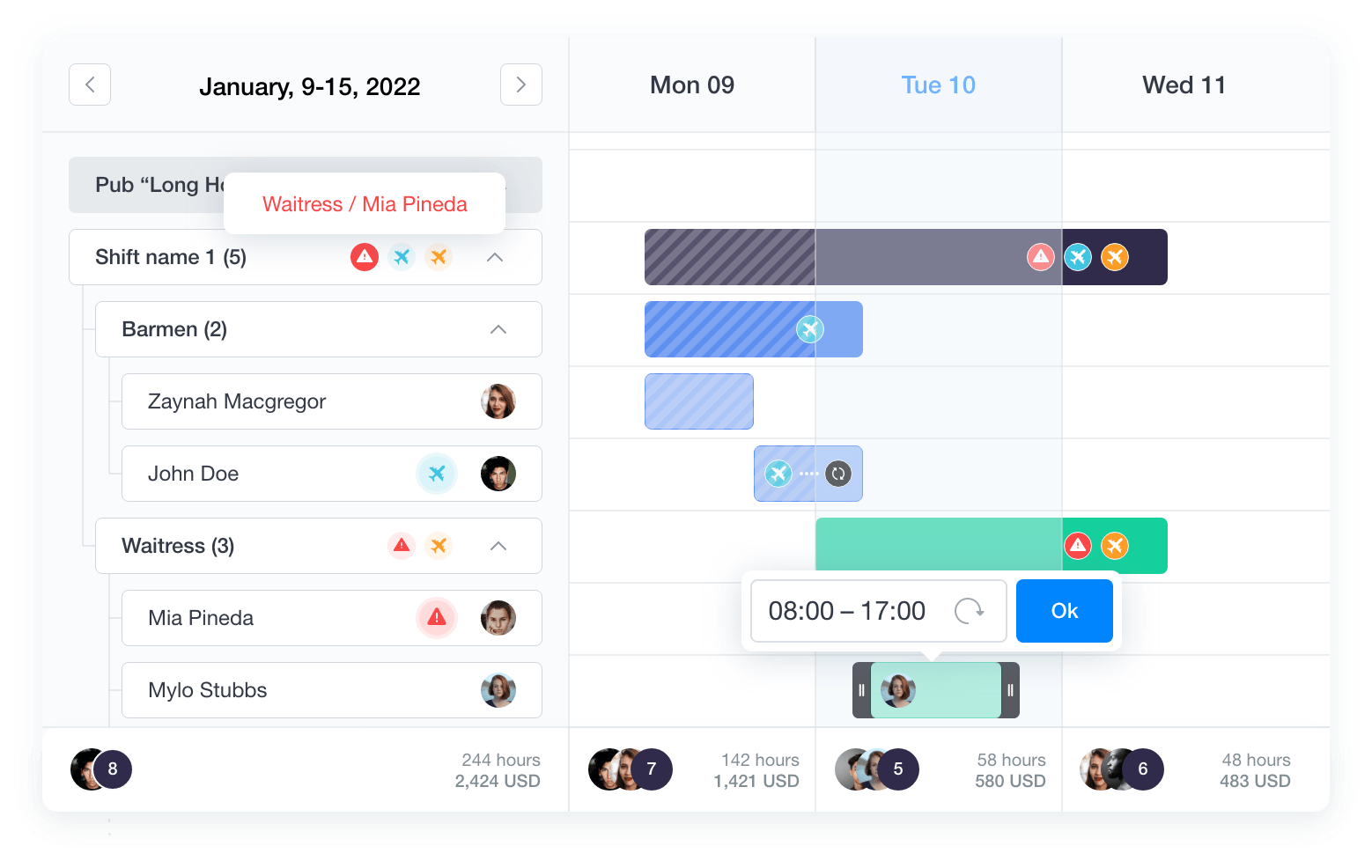
Shift planning is particularly crucial when an organization has many employees and requires continuous operations, for example, in manufacturing or warehouse companies, hospitals or medical clinics, retail companies, dining and entertainment venues (restaurants, bars, nightclubs). Effective shift planning ensures an adequate number of employees for each shift and reduces labor shortages. It also helps avoid excessive workload or unnecessary vacant positions during specific shifts.
Work time planning is related to proper setting and control of working hours. This includes recording the start and end times of work, break times, and downtime periods. Work time planning also helps ensure that employees adhere to the working time restrictions and break periods set by labor laws.
It is essential to have an efficient work time accounting and planning system that includes appropriate tools and processes. This can be specialized software that allows the creation and monitoring of schedules, tracking and recording work hours, and effectively managing the tasks and employees of your company.
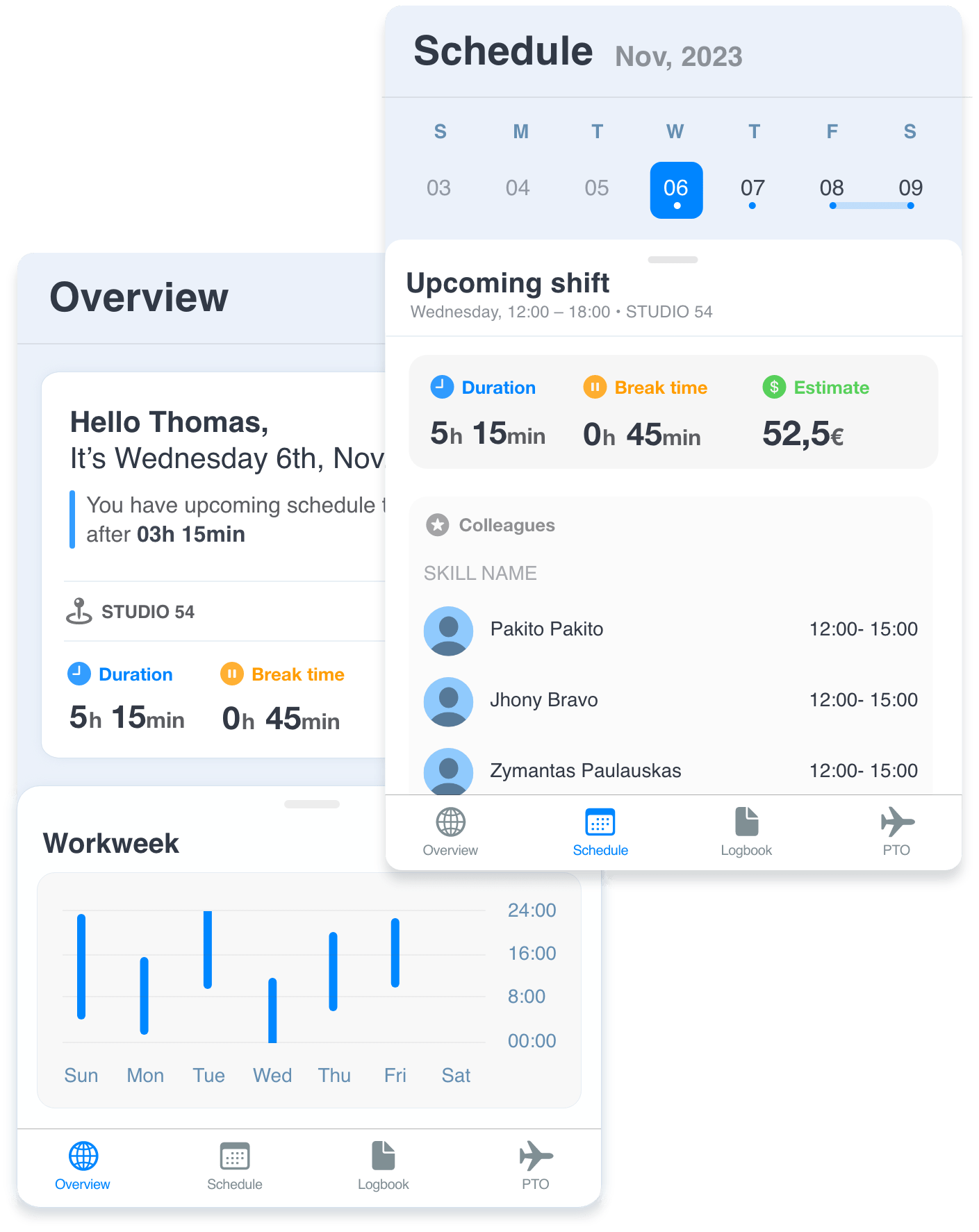
Effective shift and work time planning have many benefits for both employees and employers. It allows for better workforce planning, ensures a smooth workflow, and reduces the likelihood of disruptions. It also helps employees know their work schedules, anticipated break times, and provides the opportunity to balance personal life with work requirements.
Shift and work time planning is a crucial aspect of organizational management. It helps optimize the workforce, improve working conditions, and ensure that tasks are completed on time and efficiently. Effective shift planning and time accounting are essential tools for the success of organizational operations and the well-being of employees.
Time Tracking on Mobile
Time Tracking on Mobile is a convenient way to record and track working hours using mobile devices. It allows employees to easily log start and end times and monitor worked hours directly from their mobile application.
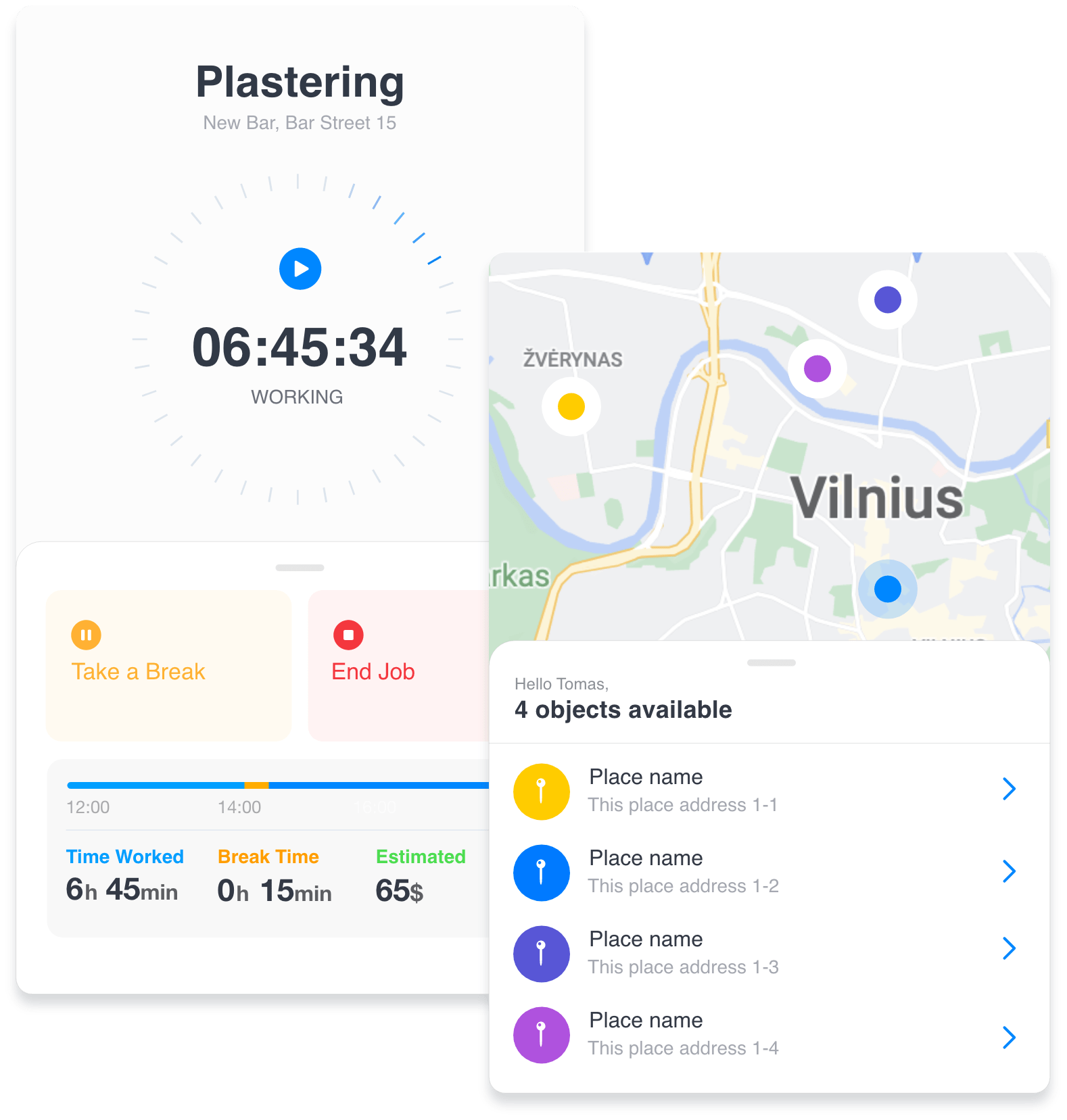
Time tracking on mobile phones has many advantages. Firstly, it is convenient because many people always have their phones with them and can easily access the time tracking program. Additionally, it allows employees to register time directly from the workplace or from any other location where they are working.
Time tracking applications on phones usually offer additional features. This may include task management, reminders about working hours, or the ability to generate reports on working hours. The ability to choose tasks performed at a specific location, project, or site. Some applications can also be integrated with other work management systems or data analysis tools, providing more detailed information about work performance and efficiency.
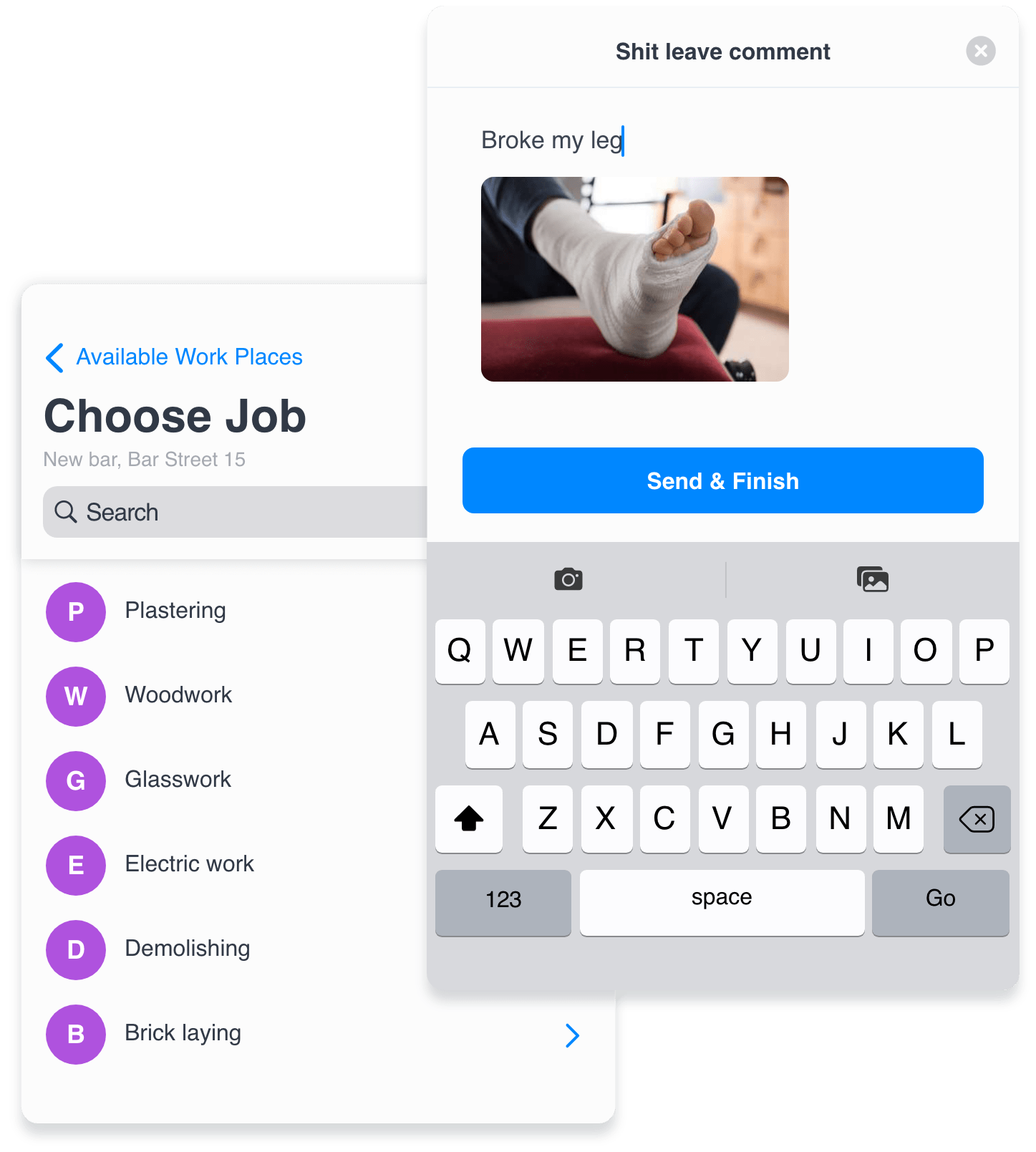
Depending on the providers of time tracking software, it is possible to have a modular system where specific access can be set for users, thus differentiating employees from managers. Managers on their mobile devices would see reports of all subordinates' working hours, as well as who is currently working, and remotely stop their working hours. Grownu software can provide such and many more time tracking solutions.
It is important to pay attention to data security when using time tracking applications on mobile phones. Reliable software providers should be chosen, ensuring that employees' personal information and working hours data will be safe and private. The Grownu time tracking system prioritizes the security of its clients' data and implements appropriate data protection solutions.
Time tracking on mobile phones is becoming increasingly popular because it provides employees with convenience and flexibility in managing their working hours. This is an effective way to record and monitor working hours, contributing to better work organization and management.
Time Tracking via Identification Kiosk
Time Tracking via Identification Kiosk is a convenient way to record and monitor working hours using a specialized stationary device. This identification kiosk can be installed at workplaces where many employees pass through control points or before starting and finishing work.
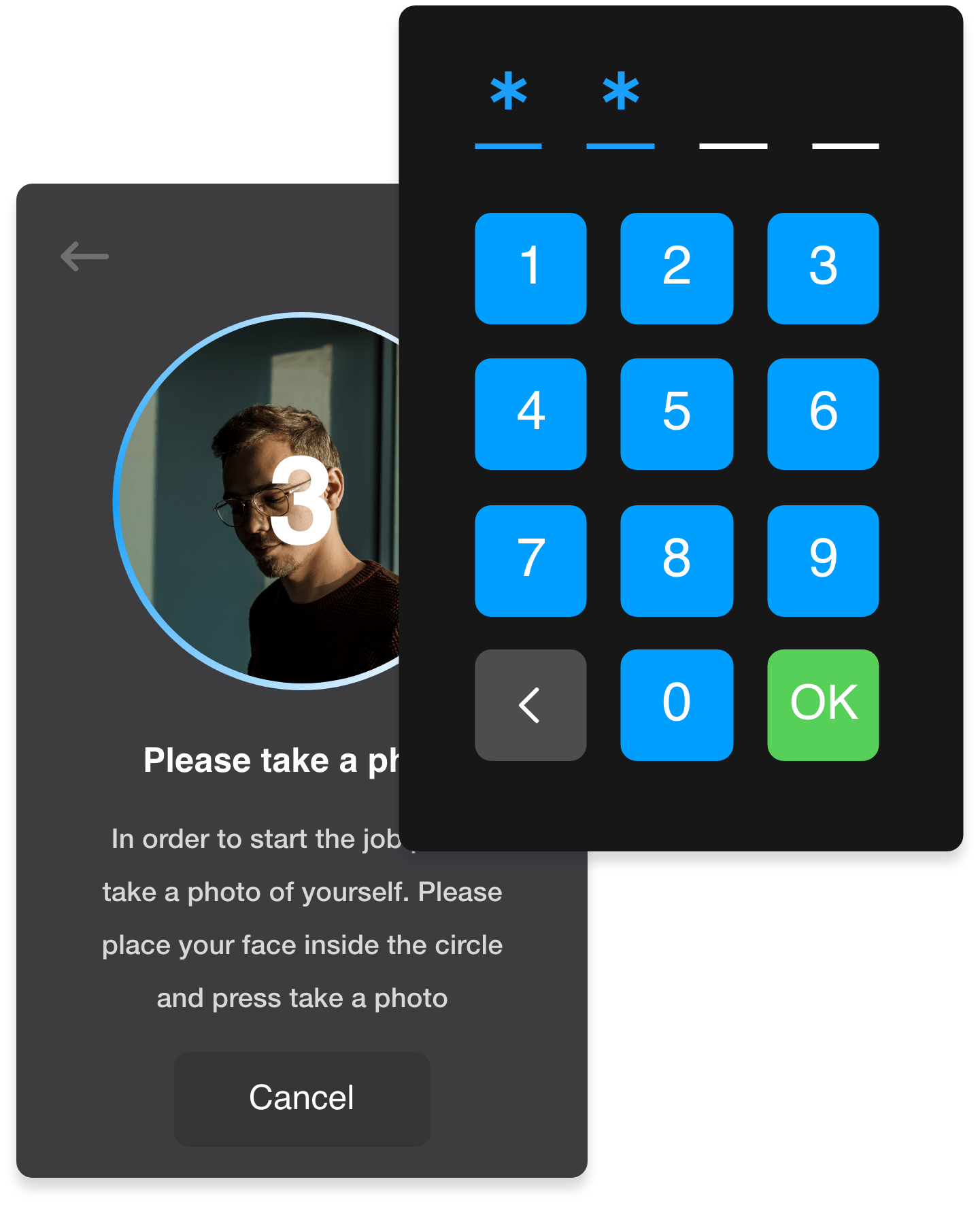
Stationary identification kiosks typically have an integrated biometric reader that allows employees to verify their identity, for example, using fingerprints or facial recognition. Employees simply pass their identity-confirming RFID element through the RFID reader to register start and end times. A four-digit PIN code assigned to each employee can also be used to start and end work. The stationary identification kiosk may prompt employees to take a photo, making it one of the most cost-effective solutions on the market, as clients don't need to invest in technical equipment such as RFID or biometric recognition systems. The photo request in the system, both before starting and finishing work, prevents dishonest colleagues from registering their peers when they are not at the workplace. Grownu's program offers such a modern and low-investment solution for time tracking and employee identification at a stationary kiosk.
Stationary identification kiosks are typically linked to special software or an electronic system where work time data is stored and managed. This allows employers to easily review and control work time records, generate reports, and perform necessary calculations, such as working hours, night hours, holiday hours, break time, or wages.
This technology provides a reliable and secure method for recording work time. Employees don't need to use paper journal entries or separate cards; instead, data is precisely and automatically recorded at the identification kiosk. This helps ensure accurate timekeeping and reduces the likelihood of errors.

Using a stationary identification kiosk and integrating it with Grownu's shift planning, it is possible to control the start time of work for each employee individually based on their assigned shift time. This means that according to the system settings, employees will be allowed to start work, or identification and work initiation will be prohibited, thereby saving company money when employees want to come early, but the employer does not require it, and is not willing to pay for hours worked earlier than scheduled.
Stationary identification kiosks are convenient and efficient tools for time tracking, especially in organizations with many employees or where it is important to accurately track working hours. They contribute to organized work management, time control, and smooth report generation.
Working Time Classification According to Types of Working Hours
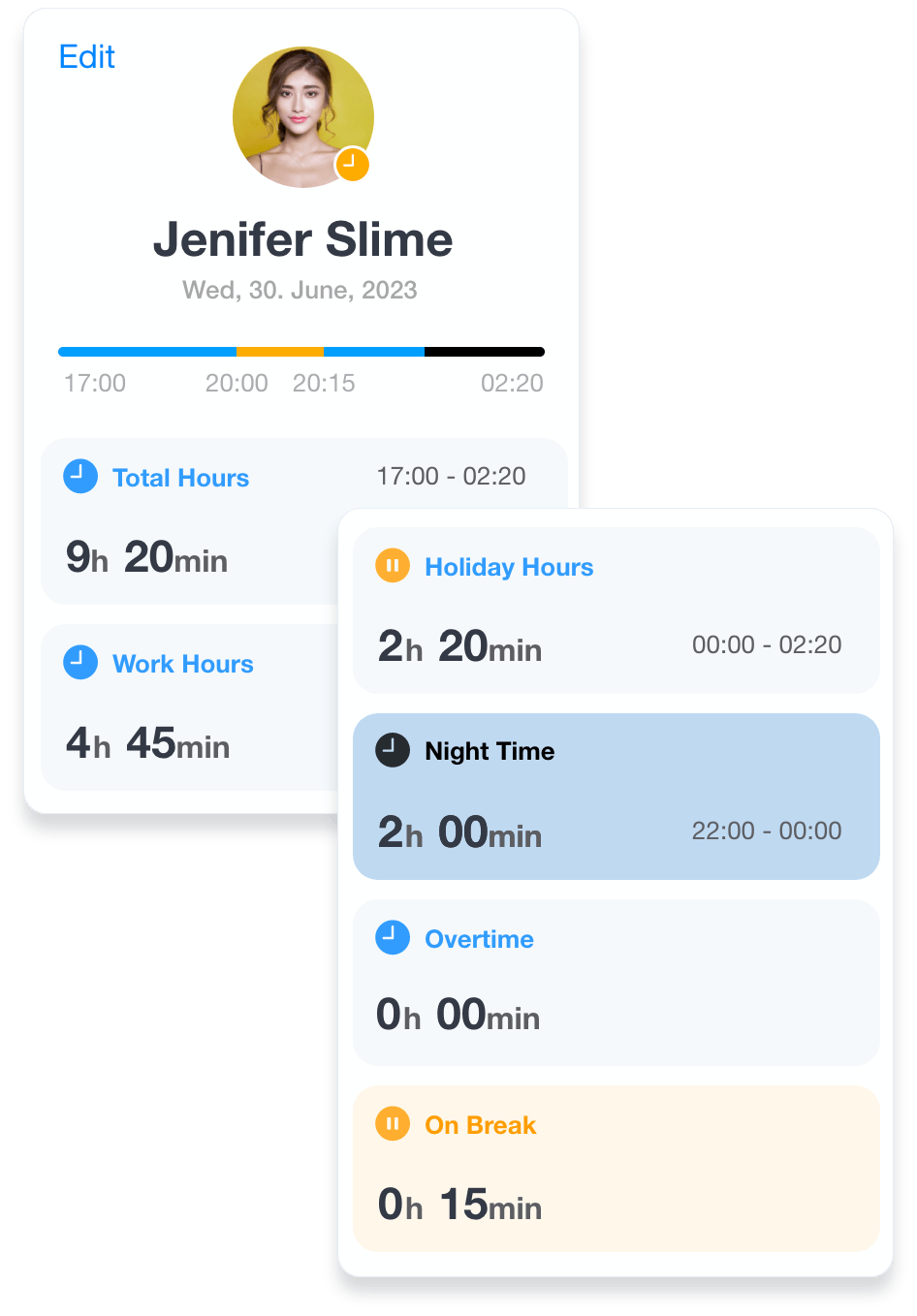
Working time can be divided into various types, which can be assigned to employees. Here are some of the most common types of working time and how the Grownu time tracking system records these types:
-
1. Working Time
This is the main working period when employees are required to be at the workplace and perform their duties. This period usually includes hours from the start to the end of the work and may vary depending on the workplace or contract conditions. In the Grownu time tracking system, this will be marked as a general work session, which has start and end times.
-
2. Break Time
This is a designated period during the workday when employees can have meals, rest, or engage in personal activities. This time is intended to refresh employees and give them the opportunity to relax from work tasks. In the Grownu time tracking system, it is possible to choose how break time for employees is calculated. Break time can be omitted if work is done under certain conditions and according to individual employment contract conditions. Employees can also be allowed to choose when to take break time, and in such cases, they should mark it on their phone or at a stationary identification kiosk.
-
3. Automatic Break Time
Most commonly used in companies when it is known precisely that break time is granted to employees according to statutory provisions, but there is no desire to give additional work to employees and record their daily break time. Therefore, automatic break time in the Grownu time tracking system allows creating records based on the actual working hours of employees.
-
4. Night Shift
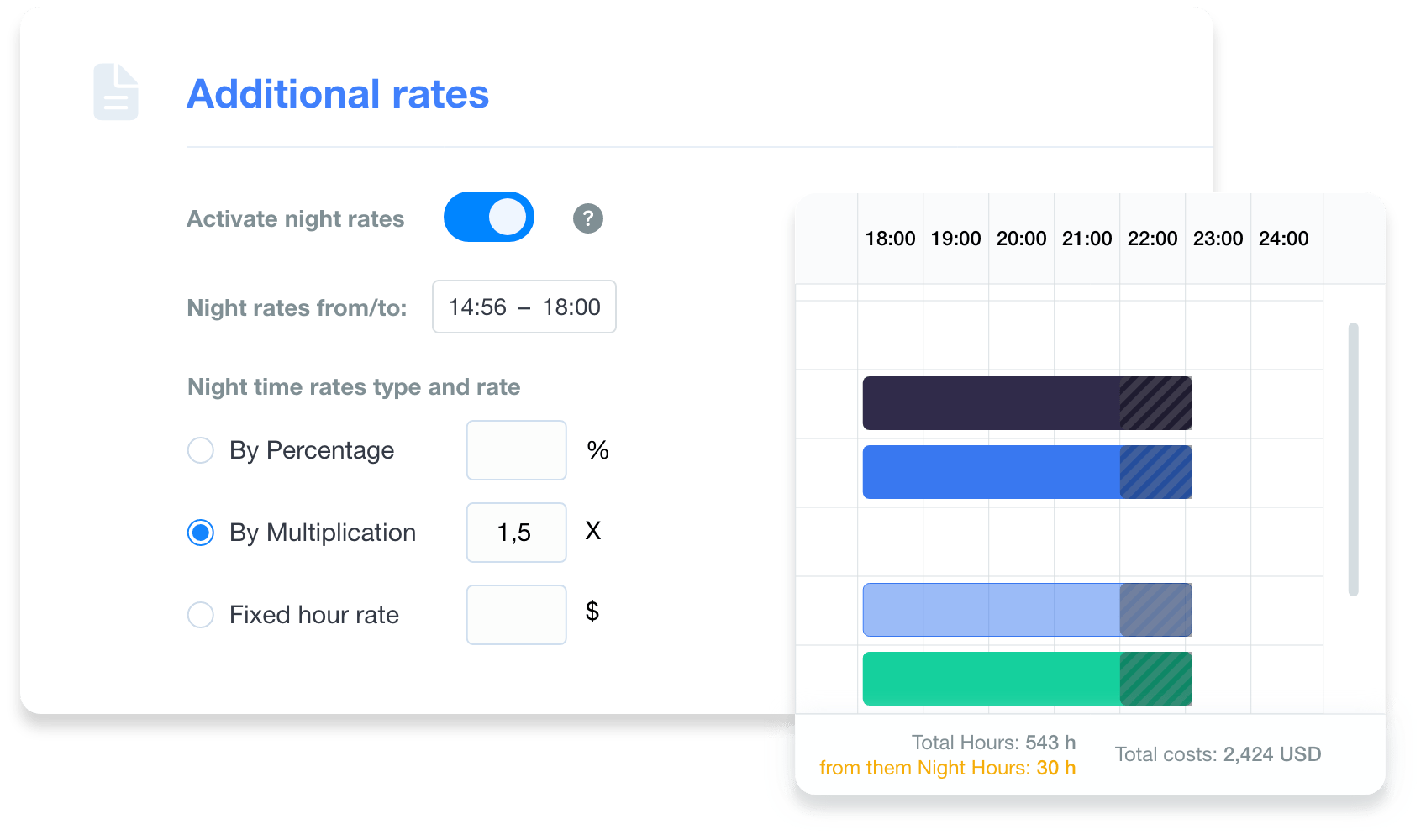
Individual settings and representation of night shift working time in the shift planning tool, one of Grownu's work time tracking solutions This is a period when employees work at night, usually from 22:00 to 6:00. This period is unique due to specific working conditions when employees must work at night when most people are sleeping. In the Grownu time tracking system, it is easy to control the start and end of night shift working time and assign a paid coefficient according to the company's needs.
-
5. Working Time on Public Holidays
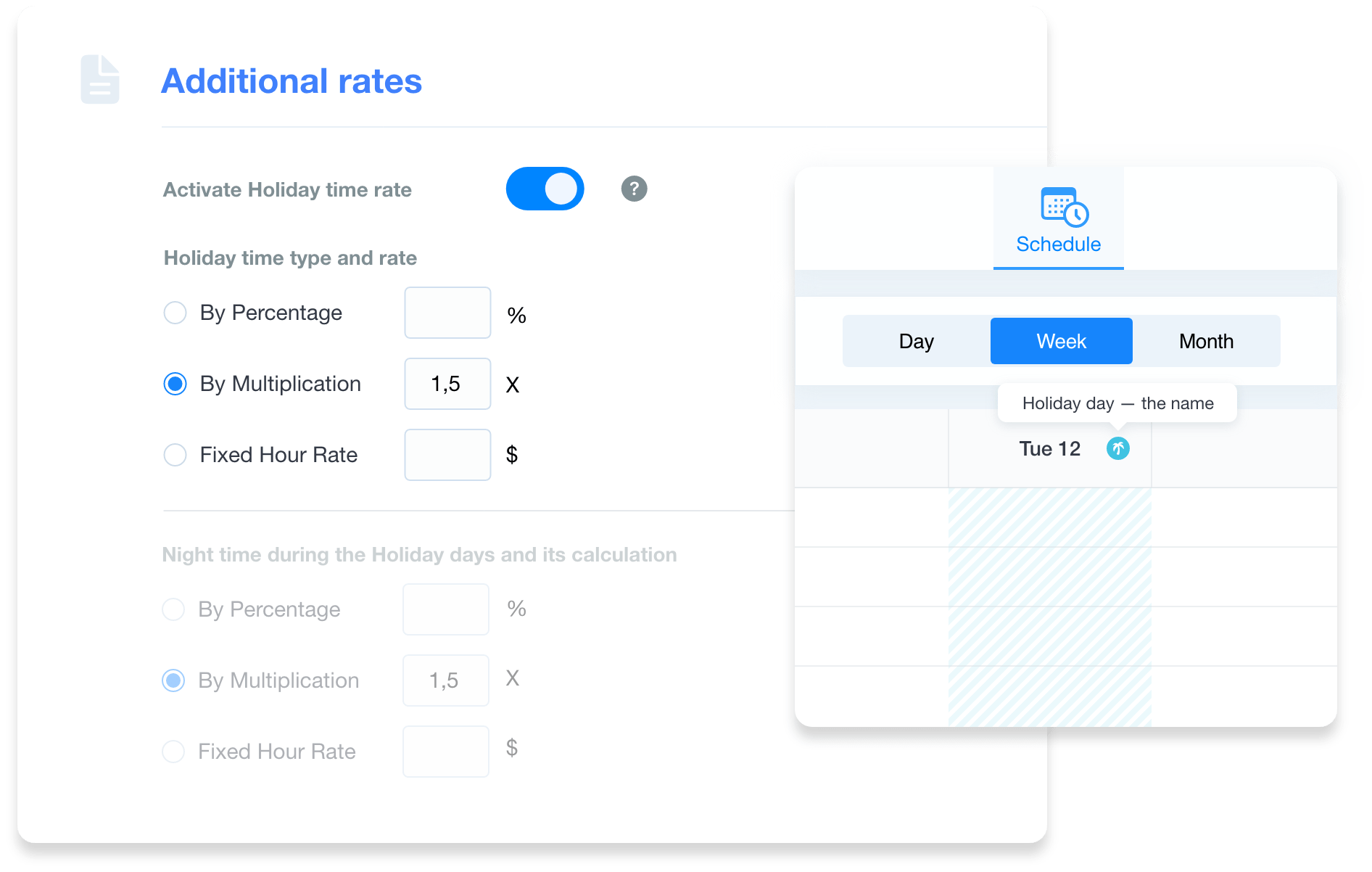
Individual settings and representation of working time on public holidays in the shift planning tool, one of Grownu's work time tracking solutions This is a period when employees officially work on recognized public holidays, such as Christmas or New Year's. During this period, employees may receive additional pay or special working conditions determined by labor laws. In Grownu's time tracking system, with a single click, you can activate the calculation of working time on public holidays and set the corresponding coefficient for such hours.
-
6. Overtime
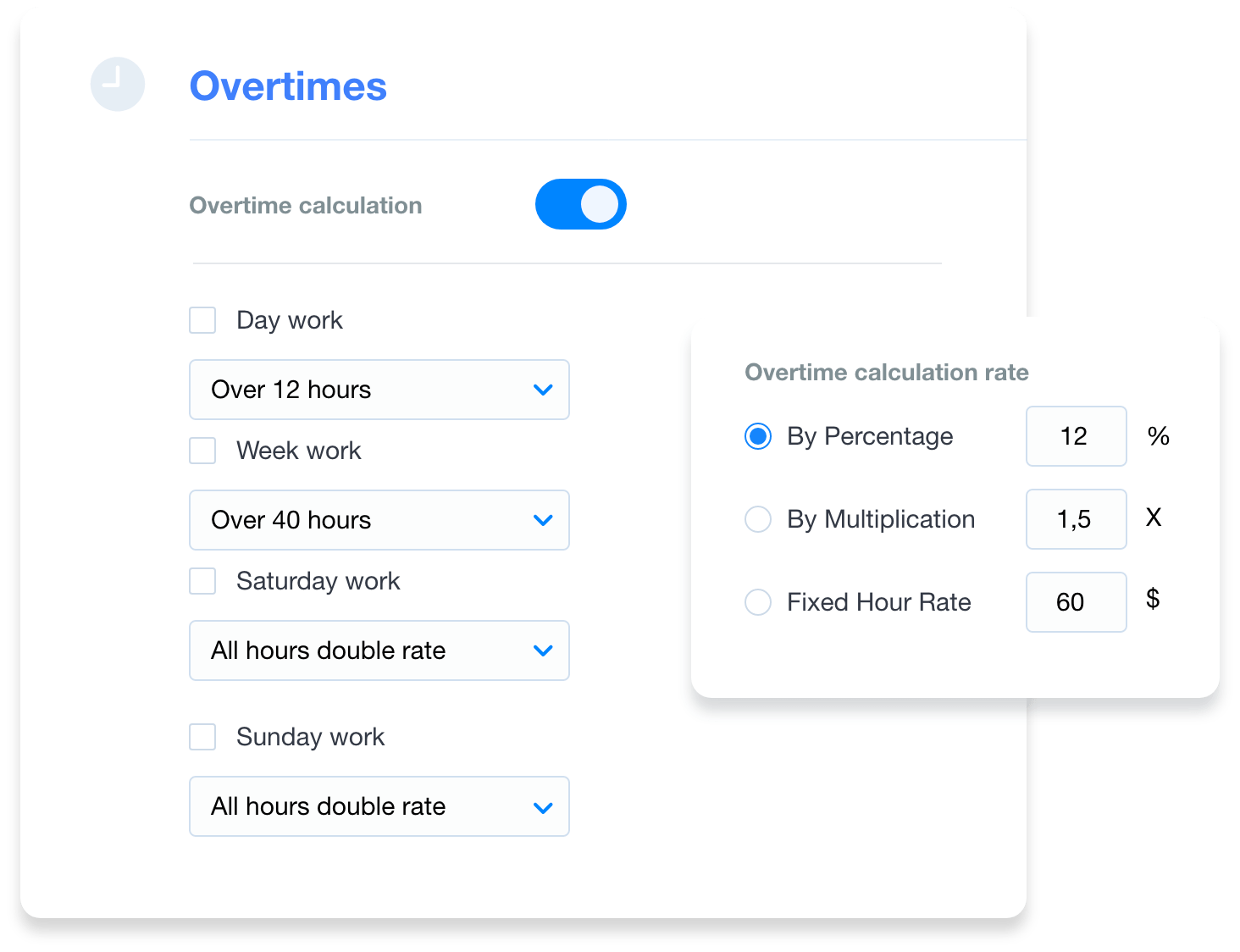
Individual settings and representation of overtime in the shift planning tool, one of Grownu's work time tracking solutions This is a period when employees work additional hours beyond the specified amount of regular working hours. Overtime is usually paid additionally and can be used for certain situations or tasks that exceed the normal duration of working hours. In the Grownu time tracking system, overtime can be set per day, per week, or per month. After collecting the number of working hours over a specified period, the following hours will be calculated at assigned overtime hourly rates. It is also possible to associate it with the Notifications module and activate a rule so that work is not possible and is immediately terminated upon reaching a certain overtime limit, thus preventing abuse of the system.
These types of working hours help organize the workday, divide the work time session into working time, night shift, working time on public holidays, overtime, and ensure employee rest, as well as define specific working conditions for certain situations or cases. They can also be regulated by labor laws and relevant agreements between the employer and the employee.
Work Time Register, Logbook
The logbook is a document that records and documents an employee's working hours. It is an essential tool for monitoring work hours, calculating wages, checking work log of employees, editing entries and adding work time entries manually if needed.

Logbook of logged in time typically includes information about the start and end time each working day, break time, night hours, and possibly other important time events such as overtime or working hours on holidays. This information is recorded to ensure accurate monitoring of working hours and compliance with relevant labor laws.
Employees usually fill out the logbook manually or use specialized software that allows electronically recording work time events. In some organizations, the timesheet may be managed and supervised by the employer or the human resources department. In the Grownu work time tracking system, all company employees can have a logbook module, and depending on assigned permissions, they can view their own records or those of other employees. The logbook is an integral part of the work time tracking system, allowing corrections and manual uploading of work hours if needed.
The logbook is an important document for both employees and employers. Employees can use the logbook as evidence of their worked hours, while employers can use it for wage calculations, conducting work time analysis, or preparing reports on productivity and efficiency. The use of a work time tracking system promotes transparency in the workplace for both employers and employees.
It is essential to adhere to the timesheet's order and accuracy. Employees should fill in information accurately and consistently, adhere to the work schedule, and maintain the timesheet correctly. Additionally, it is crucial to keep logbook of registered working time for a period specified in labor laws to ensure proper data security and availability. When using a work time tracking system, timesheets are stored indefinitely, and there is always the possibility to use relevant tools to select the necessary information and export it to Excel or PDF files.
The logbookt is a crucial document that helps manage working hours, monitor employee activities, and ensure compliance with relevant labor laws. It is an essential tool for working hour management and transparency for both employees and employers. Integration of the timesheet with accounting systems becomes an indispensable tool in daily operations and work time accounting.
Approval of Work Time Records
Approval of Work Time Records is the action by which a responsible employee officially approves and acknowledges the working hours records of subordinates. This is a crucial process that ensures accuracy and reliability in time tracking and wage calculation. In the Grownu work time tracking system, unapproved records are marked separately, awaiting review and approval. Until the working hours records in the timesheet are approved, these records cannot appear in reports and do not exist in subsequent system actions.

Approval of work time records can occur in various ways, depending on the organization and the work time tracking system used. In the Grownu work time tracking system, employees with the appropriate access level can approve the work time records of their subordinates in the timesheet. This can be done through a web browser or the Grownu mobile app.
When approving work time records, the responsible employee typically reviews whether all records are correct and match the worked hours of their assigned subordinates. If errors or discrepancies are noticed, the responsible employee must report them to the relevant human resources department or employer and request corrections. Alternatively, if the responsible employee has the appropriate access level, they can make corrections themselves.
Approval of work time records is important for both employees and employers. For employees, the timesheet provides an opportunity to review their work time records, ensuring they match their actual worked hours. This is crucial to ensure fair wages and the ability to receive compensation for overtime or other special work time events.
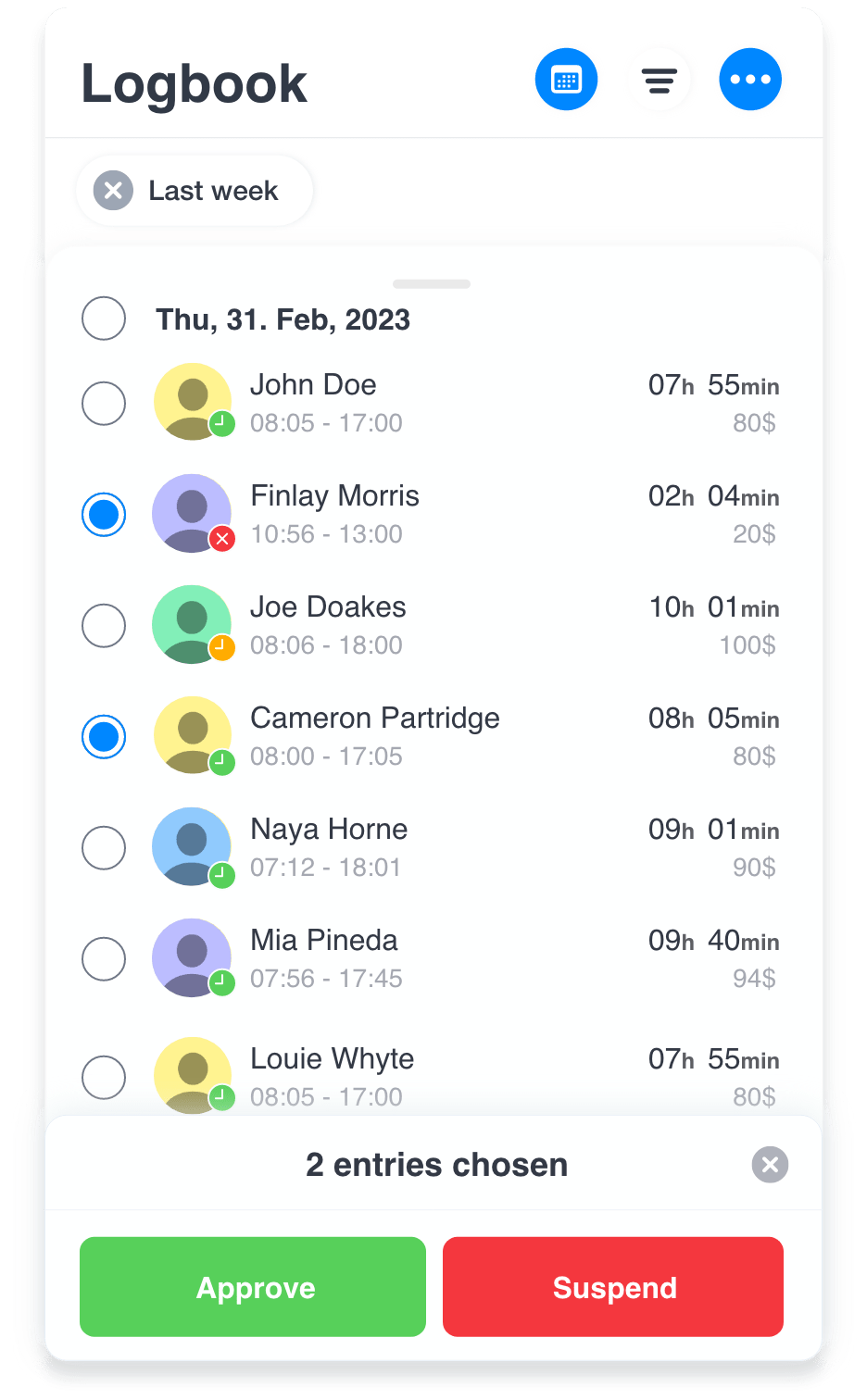
For employers, the approval of work time records is important for transparency and documented information about an employee's worked hours. This helps ensure that wages are calculated correctly and in accordance with labor law requirements.
It is crucial for employees to be honest and thorough when reviewing and approving their work time records. This helps avoid issues, errors, or disputes related to work time and wages. Additionally, responsible employees should be aware of and adhere to the requirements and deadlines specified in labor laws related to the approval of work time records.
Work Timesheet
Work Timesheet is a document that provides structured information about an employee's worked hours during a specific period. This format allows recording and monitoring work time data in an organized and clear manner.

A Work Timesheet typically includes columns reflecting various time elements, such as dates, start and end times, break time, night work hours, overtime, and other work-related events. Each workday is assigned a separate row, and all rows form the structure of the table.
A Work Timesheet can be created manually using a blank template or a pre-prepared table. Electronic work time management systems or special programs that allow creating and storing work time data in digital format can also be used. In the Grownu work time tracking system, within the Work Timesheet module, you can quickly filter the desired information for a specific period, selected employees, or location. After reviewing the information and, if it meets requirements (no corrections needed), we export it to an Excel format document, which can later be shared with the necessary company departments.
This Work Timesheet is essential for both employees and employers. Employees can use the Work Timesheet as a tool to monitor their working hours. Employers can use the table to calculate wages, create reports, plan work schedules, or analyze work time trends.
It is important that the Work Timesheet is neat, accurately filled out, and follows the established rules of timekeeping. Employees should fill in the required fields, enter accurate time data, and adhere to the established procedures, or this should be done by electronic work time tracking systems. Employers should ensure that the table is accessible to employees, check its accuracy, and use it for relevant calculations or analysis. In Grownu's work time tracking system, each employee has access to their own data and Work Timesheet, and relevant employees with higher access levels can view the Work Timesheet of other employees.
The Work Timesheet is a useful tool for calculating and accounting for worked time. It helps ensure accuracy, transparency, and document information about an employee's worked time, contributing to effective work management and compliance with relevant labor laws.
Work Time Reports
Work time reports are documents that provide information about an employee's worked hours during a specific period. These reports are important for both employees and employers as they help monitor and document working hours and perform relevant calculations.
Work time reports can be generated for different time periods, such as weekly, monthly, or quarterly. They include information about each workday, including start and end times, break time, night work hours, overtime, or other work-related events. In the Grownu work time tracking system, the generated reports can be segmented by various time periods and other filtering criteria, such as location (place, project, object), type of work performed, employee (or group of employees or that group's subgroup), and more. The advanced Grownu reports module allows the user to extract the required information here and now.
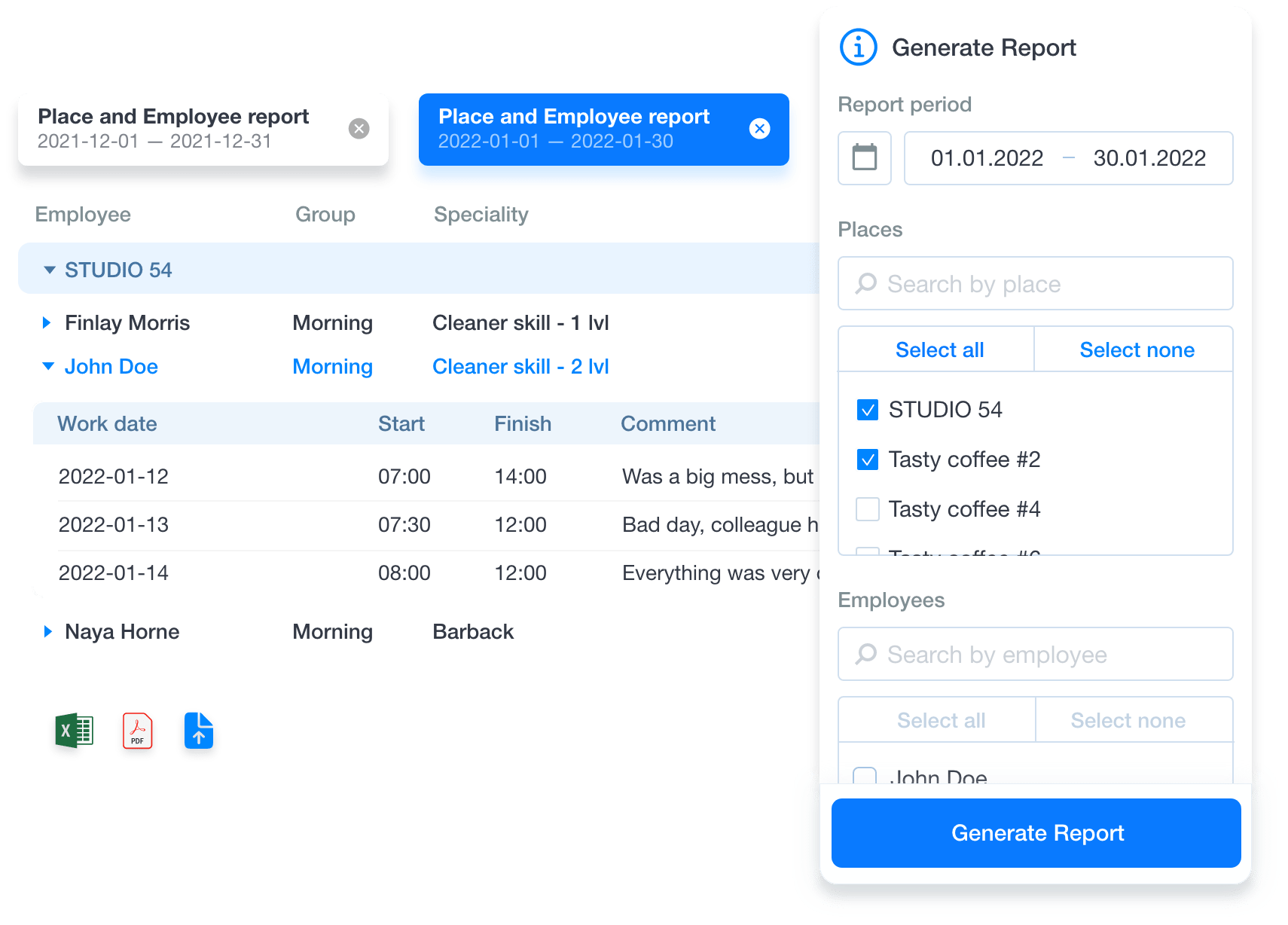
Work time reports can be filled out manually, using special software, or electronically through work management systems. They are often submitted to the relevant human resources department or employer, who can then use this information for wage calculation, report generation, or work hour analysis.
These reports are important for employees as they provide an opportunity to monitor and verify their work hours, ensuring that their wages are calculated correctly. They can also be useful for tracking and planning work time, such as setting schedules or planning vacations.
For employers, work time reports are important as they help manage the workforce, calculate salaries, and perform work time analysis. Employers should ensure that the reports are neat and accurate, thus ensuring proper work time management and calculations. These reports can be used to ensure compliance with labor laws related to time and wages and document information about employee activity.
Reports on Violations of Working Hours
Reports on violations of working hours serve as a communication tool through which employees or employers inform about breaches or non-compliance with the working hours rules established within the company or according to labor laws. These reports are intended to highlight and address issues related to working hours.
Employees can submit reports on violations of working hours if they notice that other employees are not adhering to the work schedule, working overtime without proper recording, or violating other working hours rules. These reports can be submitted directly to the employer, the HR department, or the relevant administrative unit.
Employers can also submit reports on violations of working hours if they observe that employees are not following working hours rules, not performing assigned tasks, or violating work procedures. These reports can be directed to respective employees, the HR department, or other related structures.
Reports on violations of working hours should be submitted in a timely manner, be detailed, and supported by factual data or examples. They should include information about specific violations, the relevant time period, the work location, and any other relevant factors. This helps identify and take action against violations.
Reports on violations of working hours are crucial to ensure proper management of working hours, discipline, and fairness for both employees and employers. These reports help identify breaches, take corrective action, and ensure that working hours rules are followed, and working hours are used appropriately and legally.
Reports on Violations of Working Hours
Violations of working hours involve actions or behaviors that violate working hours rules or fail to comply with established requirements for working hours. This can include various actions, such as arriving late to work or leaving the workplace without permission before the designated time, unauthorized extensions of breaks, or unauthorized overtime.
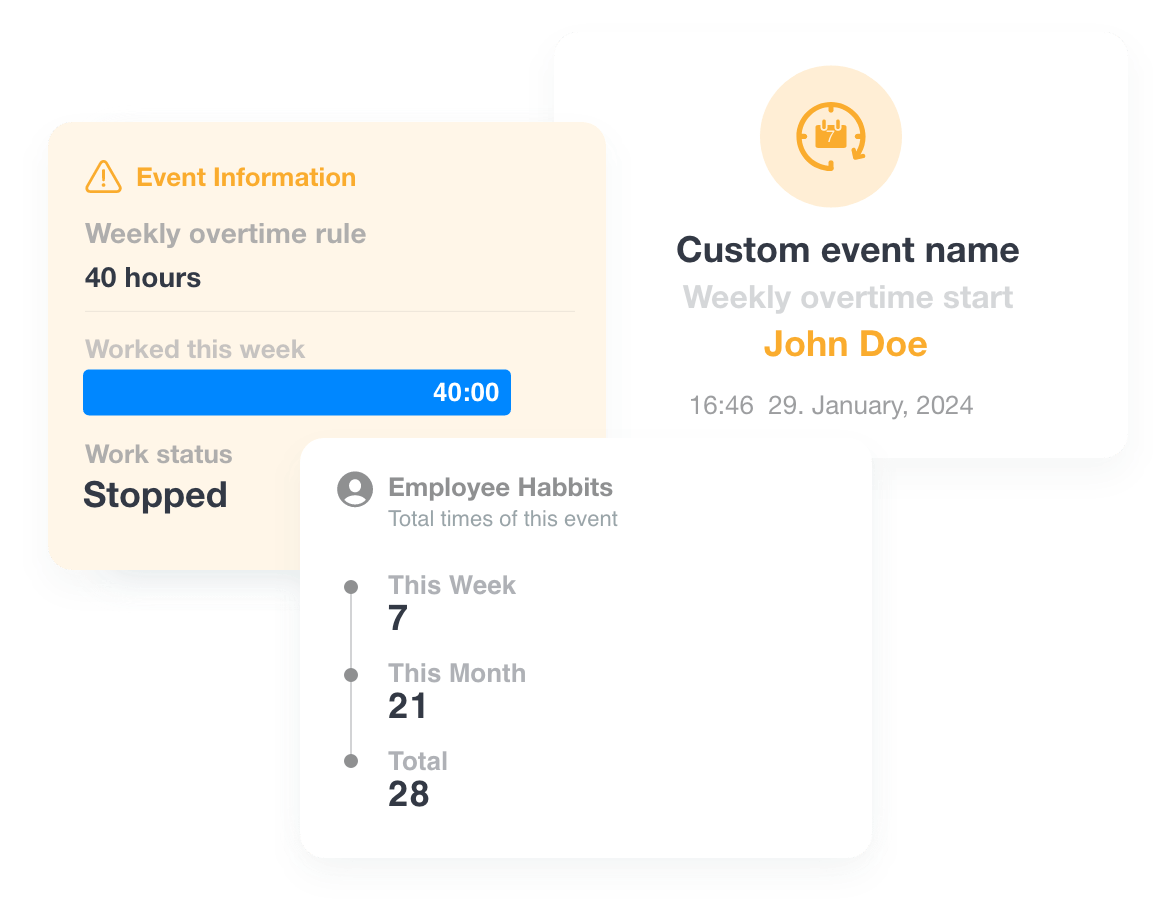
Violations of working hours can have a negative impact on both the employee and the employer. Employees who do not adhere to working hours rules may receive reprimands or severe workplace violation reprimands, conflict with the employer or colleagues, or even lose their job due to violations of work order. Employers facing violations of working hours may experience a decrease in productivity, financial losses, or even potential damage to their reputation.
It is important to take measures to prevent violations of working hours and promote proper time management. This may include establishing clear working hours rules and familiarizing employees with them, implementing working hours monitoring and control systems, and applying necessary sanctions for violations of working hours.
Violations of working hours must be taken seriously and addressed appropriately. This can include warnings, documentation of work order violations, fines, or even possible termination of the employment contract depending on the seriousness and recurrence of the violation.
Grownu's time tracking system allows you to create customized reports tailored to any company activity. Such reports include being late to work at a specific time from the planned start of the work shift or leaving the workplace before the designated work time. Late exit from work (e.g., the place is no longer working, but the employee stays and performs extra tasks, and his working time is counted). Early exit from work (unworked hours). Reminders to employees about the start and end of their working hours sent to their mobile devices according to their planned work shift and much more.
Proper time management and prevention of working hours violations are crucial to ensure an effective work process, transparency, and fairness for both employees and employers. Adhering to working hours rules and addressing violations helps maintain a healthy work environment and a good working relationship atmosphere.

Contact the Grownu Team
Reach out and start planning shifts and recording work hours now!
Check if Grownu is right for you by trying the fully functional version for free!
No credit card required. No software installation needed.